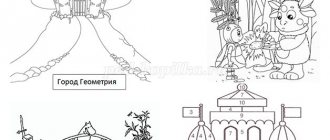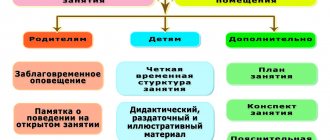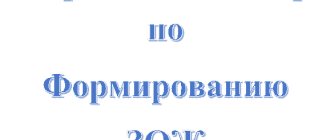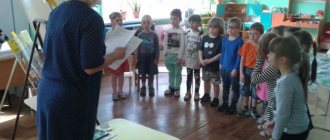Features of an open lesson in mathematics in the middle group of preschool educational institutions
Open viewing of FEMP is an effective form of organizing the pedagogical process in kindergarten. Being one of the varieties of mathematical classes, this educational activity also solves educational, developmental and educational problems.
Educational objectives in the middle group are related to the content of the program. This is counting within five, comparing objects by size (by two characteristics at once), building a serial series, getting to know new geometric shapes (rectangle), developing orientation in space, expanding time concepts. In this case, an open mathematical lesson usually touches on several of these problems at once.
The developmental tasks of an open lesson are associated with the development of the intellectual sphere of a preschooler - the processes of thinking, attention, perseverance, and the development of correct speech. At the same time, the work is organized in such a way that the child acts as a leader, takes an active position, and reveals his abilities to the maximum.
Each open mathematical lesson necessarily carries an educational value. The teacher must select a topic that will contribute to the development of positive moral qualities in the preschooler, for example, love for his native land, the desire to treat plants and animals with care, etc.
When thinking through the content and structure of an open mathematical lesson in the middle group, the teacher should focus on the following important aspects.
- Meaningful. The open viewing should become a source of innovative experience for colleagues, touching on current problems of modern methods of preschool education, as well as child psychology. An innovative approach can be expressed in the very content of visual or handout material, or in some interesting methodological technique, the use of ICT, unusual organization of space, etc. After all, showing traditional mathematical activities will not contribute to the professional growth of the specialists present.
- Social. During an open lesson, the teacher creates a situation of success for preschoolers. To achieve this, praise, encouragement, and giving the child the right to make mistakes are actively used. The teacher demonstrates the strengths of children, revealing their thinking and creative abilities.
- Pragmatic. Open viewings of FEMP are an additional incentive for cognitive activity for middle group students. They enjoy playful activities (which always accompany such events) and attention from adults.
In an open lesson with children of the fifth year of life, the following is required:
- clear organization and planning of each stage of educational activity (unlike, for example, mathematical entertainment, where the script allows improvisation);
- a mandatory intriguing start to the lesson, which will become a motivating moment for children;
- coherence and logic of the plot (usually a journey is chosen, helping a fairy-tale hero, achieving a common useful goal);
- individual approach to children (the mental and somatic development of children is different, for example, someone else has speech problems);
- original visual aids that invited teachers will be able to produce and use in their practice;
- the teacher's friendly tone, appropriate facial expressions and gestures.
In order for the open event to be successful, all planned goals are realized, the topic is revealed, the teacher needs to prepare a detailed summary (which he coordinates with the preschool educational institution methodologist). Every action of the teacher is written down there: introductory remarks, assignments, questions, comments on them during the lesson, expected answers from children, etc.
As for organizational aspects, an open mathematical lesson in the middle group is conducted without “rehearsal” and has the usual duration for this age (20 minutes). Although children of the fifth year of life are no longer babies who can cry when they see strangers, you should still psychologically prepare the children for the event, and also inform their parents about it in advance.
Guests of open viewing are always provided with workstations behind preschoolers (so that they do not distract children from cognitive activity).
At the beginning of the lesson, the teacher draws the children’s attention to the adults present and offers to say hello to them - then the kids will not look at them during the activity.
Sometimes parents are also invited to open screenings - this is useful for strengthening family relationships and gives mothers and fathers a real idea of the level of knowledge and skills of their children. In the middle group, this can be practiced, but with caution, because there are always children who can get up and go to their mother during class. In this case, work with the rest of the children should continue as usual.
Methodology for conducting an open lesson in mathematics in the middle group (structure and forms of work)
Open viewing, being a type of educational activity, has a certain structure.
- Organization and motivational beginning of a lesson that stimulates preschoolers to cognitive activity (2–3 minutes).
- Main stage. Completing tasks that reinforce certain mathematical concepts, since during an open demonstration, an explanation of new material is usually not given.
- The final stage. Summing up (2-3 minutes): the teacher asks preschoolers to share their impressions of the event, talk about what they liked most and what caused difficulties.
During an open lesson, the teacher must alternate different forms of children's activities. This will enliven the course of the lesson and allow each child to reveal the abilities. The most appropriate would be a combination of group and subgroup types.
- Collective activities: frontal survey;
- didactic games;
- physical education minutes;
- finger games;
- outdoor games with mathematical content.
Individual work is an important part of an open mathematics lesson





